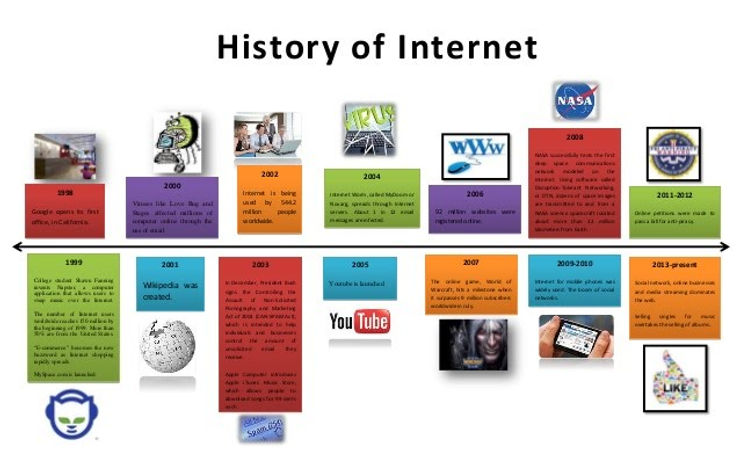By: Bryan Zou
The internet is constantly evolving, and many people use it in their daily life. For people living in the 20th century, the miniscule size of the web or internet would seem unfathomably small compared to the global reach it has today.
To understand the history of the internet, we need to understand how the internet works fundamentally. The internet is essentially a network of networks, or a web. When someone refers to the internet, they usually refer to the World Wide Web. It serves as a way to communicate between devices. A device sends data through packets to another device that can process that information. Usually this is done through physical cables that can be made of various materials. These wires can be seen around the world, running along the seafloor to cross oceans.
Devices can connect to the internet through a router. Instead of connecting each device to each other, which is very inefficient, the devices connect to a router. A router routes the information to the internet. From there, the internet can decide where to move the information to. These routers are used everywhere and are connected through the internet. Compared to having hundreds of computers linked together through thousands of cables, routing certainly plays a big role in today’s internet.
What are websites though? The internet also houses servers, which can carry websites in their hard drives. These servers all have a unique address, known as an IP address, that carries the location of the server on the internet. This gives devices an easy way to access websites. The data packets mentioned earlier also can be combined to make a larger set of information, like a jigsaw puzzle.
Now that we know the gist of the internet, we can finally explore the history of how the internet came to be. Before the 1960s, the internet was just a simple cable between computers that are known as local area networks or LAN. Because they needed direct connections, the networks were very small. One MIT scientist named J.C.R. Licklider wanted a better way for computers to communicate and came up with an idea to make a global computer network.
Licklider shared this idea with colleagues in the U.S. Department of Defense, Advanced Research Projects Agency (ARPA). His idea spread to Leonard Kleinrock, Thomas Merill, and Lawrence G. Roberts who developed a packet-switching theory. The idea was to have a way to send packets of data through a web of connections, where the information could travel down any path but still end up at the correct destination. For this to happen, packets would need to be standardized across computers, even if the computers were coded differently. Roberts made a plan utilizing these techniques that was called ARPANET.
Their idea came into fruition in 1969, which converted packets into a standardized format before data was transmitted to other computers. The internet at the time was still in its infant stages, without a simple set of rules or guidelines on how to transmit data properly. In 1973, Robert Kahn and Vinton Cerf collaborated to develop a protocol (procedure / rules) to link multiple networks together. It’s now known as the Transmission Control Protocol/Internet Protocol (TCP/IP).
A couple years later, one engineer named Robert Metcalfe, who worked at 3com, developed a cable system capable of transferring more data, now known as Ethernet. Around this time, Ted Nelson first proposed an idea that we now know of as HTML, a way to organize data on the web as text. Dave Farber also came up with an idea to build an inexpensive network that used preexisting phone lines as cables for the network. This system was established in 1980 and named PhoneNet. It was then connected to ARPANET along with the first commercial network Telenet.
The use of phone lines allowed for internet and email communication between multiple nations. MetCalfe’s company also announced commercial Ethernet products for computers; LAN’s were now able to be established by any consumers. In the same decade (1980), Paul Mockapetris, Jon Postel, and Craig Patridge created the Domain Name system that we still use today. A domain is the website’s name in a way, like google.com. This system made it easy to manage the increasing users of the web.
Finally, in the 1990’s, Tim Berners-Lee and his colleagues developed the HTML that we know of today, as well as the uniform resource locator (URL). A URL is a way to represent the resources of a server or website into an address that contains useful information. From then, the World Wide Web (www) was established, which is a system that connects networks throughout the world. Without HTML and URLs, it’s likely the internet wouldn’t have gotten to the point that it is today.
The internet’s popularity exploded from then, with users across the globe creating servers, making websites, or just browsing the internet. This is where the Web got its name, as the millions of connections resemble a web. Innovations were being made left and right, like WiFi or fiber optic cables. Looking at the web today, it seems impossibly larger than what it was today. When looking at the dozens of cables running across the seas or millions of connections throughout countries, just remember that it all started from two computers linking via a cable.
Sources:











